|
|
|
|
Book Reviews from the Staff of the Poison Pie Publishing House
|
|
December 15, 2018
Bestiaries of 2018
In the year 2018, the staff of the Poison Pie Publishing House continued their weekly update of A Survey of One Hundred Bestiaries. (The survey has now grown to over 230 entries, although its title has not been updated.) A number of these bestiaries were published in 2018, including
- Mordenkainen's Tome of Foes (Wizards of the Coast) (227)
- Atlas Animalia (Metal Weave Games) (228)
- Pathways Bestiary (Rite Publishing) (229)
- Sagaborn Creature Compendium (Lone Wanderer) (230)
- In the Company of Dragons Expanded (Rite Publishing) (231)
- Sandy Peterson's Cthulhu Mythos (Petersen Games) (232)
- Alien Archive 2 (Paizo Publishing) (233)
- Creature Codex (Kobold Press) (234)
- The Bestiary of Equestria (River Horse) (235)
- Construct Handbook (Paizo Publishing) (236)
- Guildmasters' Guide to Ravnica (Wizards of the Coast) (237)
We enjoyed reading each of these bestiaries. No two volumes are ever quite alike. Each contribution brings with it a unique approach and new creatures. We recommend investigating all of them to the interested reader. The survey provides publication information and a fragment of a single beast entry for each book. In this document, we limit our efforts to highlighting only a few of the bestiaries published in 2018.
|
|
|
|
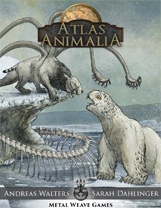 |
|
Atlas Animalia (Metal Weave Games, 2018, #228)
|
This bestiary introduces variations of the archetypal versions of mythical beasts, each suited to a particular ecological niche. For example, the gila basilisk is found only in desert environs. The undersea chimera sports the heads of a dolphin, a moray eel and an angler fish. Or, as shown on the cover of the book, the polar owlbear, who dwells in arctic climes. Most monsters have several variations, though not are all versions adapted to a particular climate. Some entries, like the lionfish hippocampus, modify the traditional beast to incorporate the features of a different model animal. The okapi unicorn and the peacockatrice are two more examples in this vein.
The entries are all clever and the descriptions well suited to the variation. Each entry is beautifully illustrated. Reader's familiar with the first and second volumes of the Baby Bestiary series from Metal Weave Games, will find the high quality of textual and graphical description on par with what they have come to expect from those books.
This bestiary turned out to be our favorite such book published in 2018. Like the Baby Bestiaries, this book does not include system-specific statistics. For RPG fans, there is a companion stat book due in early 2018.
|
|
|
|
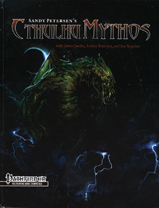 |
|
Sandy Peterson's Cthulhu Mythos (Petersen Games, 2018, #232)
|
This 500-page tome, long in the making, serves as a comprehensive resource to a campaign incorporating elements of the writings of H.P. Lovecraft. The book is much more than a bestiary. The first seven chapters provide information to players and gamemasters regarding playable races, character options, insanity mechanics, magic items and cults. Relevant to our survey are the final three chapters: Chapter VIII. Great Old Ones and Outer Gods, Chapter IX. Mythos Bestiary and Chapter X. Expanded Mythos Bestiary, which collectively run 295 pages. This book is compatible with the Pathfinder Role Playing Game.
Of course, there are numerous previously published tomes which serve as Lovecraftian bestiaries (see survey entries 108, 109, 110, 214 and 215) as well as more general bestiaries, which include Lovecraftian horrors (such as entry 17, which features Cthulhu on the cover). Nevertheless, this volume is appealing as a comprehensive collection of many relevant elements, described in a consistent manner, as well as in the authoritative nature of the presentation. Many of the entries in the bestiary-like chapters have some graphical entry, though most are photographs of painted miniature figures.
For those planning adventures in Lovecraftian realms, this tome will prove an invaluable resource, beyond the entries in the bestiary.
|
|
|
|
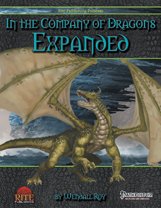 |
|
In the Company of Dragons Expanded (Rite Publishing, 2018, #231)
|
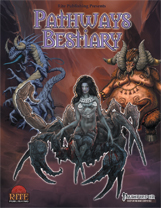 |
|
Pathways Bestiary (Rite Publishing, 2018, #229)
|
The folks at Rite Publishing have released two books that appeared in our survey of bestiaries in 2018. We comment first on The Pathways Bestiary, which provides over sixty templates to modify creatures. Many readers may consider the d20 (2004) and Pathfinder (2014) editions of the Advanced Bestiary to provide the definitive template bestiary, but, as should be obvious from our survey, there is always room for more. The Pathways Bestiary provides at least one example of the application of the template to a base creature, providing a proper bestiary-like feel. In numerous examples, supplementary material, such as new spells related to the theme of the template are also presented.
Often, one thinks of bestiaries as encyclopedias of monsters, in which an alphabetical list of entries is catalogued. In our survey, we have also included many volumes of a different kind, which provide a deep investigation of a single type of beast and its variations. One need think no further than the various editions of the Draconomicon (entries 24, 25, 26, 121), which focus exclusively on dragons, or the numerous Van Richten's Guides (entries 185-193, 196-198), which each focus on a particular category of undead. In the Company of Dragons follows this example and adds a new twist, including all of the relevant material as a complete supplement to presenting the dragon as a playable race. This is the most complete version of the In the Company series developed by Rite Publishing, although others, like In the Company of Gelatinous Cubes Expanded has found a soft spot in many adventurers' hearts. Two hundred pages are devoted to providing a complete breadth and depth to the concept of the dragon as a player character. To our way of thinking, this excess of information is vastly preferable to the alternative, which is to introduce a new playable race through a small box of variations in the game mechanics. Does having a dragon in the party present a threat to game balance, if all characters do not adopt a bestial race? Of course, but if a player chooses to venture forth in the company of a dragon, he or she can hardly expect to go toe-to-toe with their companion in terms of martial prowess.
|
|
|
|
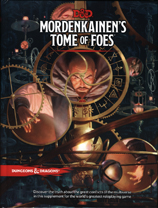 |
|
Mordenkainen's Tome of Foes (Wizards of the Coast, 2018, #227)
|
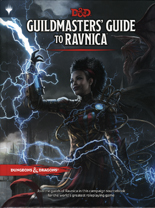 |
|
Guildmasters' Guide to Ravnica (Wizards of the Coast, 2018, #237)
|
Wizards of the Coast continue to deliver high-quality books for the Fifth Edition of the Dungeons & Dragons role-playing game. The two entries for 2018, Mordenkainen's Tome of Foes and Guildmasters' Guide to Ravnica deviate from the traditional catalog of beasts, in a manner not all that different from the Cthulhu Mythos described above. There are chapters dedicated to campaign background, magical items or new playable races, but both volumes include a non-negligible bestiary chapter. The illustrations in both volumes are in keeping with the artistic approach of the Fifth Edition. We thoroughly enjoyed both these books. We say little more in our review only because so many other reviews are available for books released by one of the two leading publishers in the RPG industry.
|
|
|
|
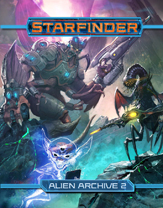 |
|
Alien Archive 2 (Paizo Publishing, 2018, #233)
|
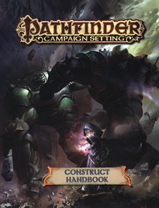 |
|
Construct Handbook (Paizo Publishing, 2018, #236)
|
Of course, the other leading publisher in the industry is Paizo Publishing, responsible for the Pathfinder and Starfinder RPGs. The quality of their publications are uniformly high. (Some may wonder why we dwell on production and writing standards, but in a field, like role-playing games, in which the creativity of participants is essential, there are a plethora of contributions from parties who can best be characterized as part of a "cottage industry" if not "individual self-publishers". For readers who prefer glossy polish, one can find that in the bestiaries of Paizo and Wizards of the Coast. For those who enjoy the individual creative vision, less tethered to the necessity of success in the commercial market, there are other many other alternatives in the survey.)
In any case, Alien Archive 2 is the second Starfinder bestiary. The originality of the beasts therein is very satisfying. The only criticism that we have of this book and of the Starfinder game in general is that it is too-focused on game balance through uniform mechanics. There is no attempt to hide the adherence to this philosophy in the presentation of the material. One can see that one is merely changing a few variables in the algorithm to move from one race to another. This is all well and good for a video game, in which the capabilities of the characters are calculated by a computing processor, but in a tabletop RPG this transparent uniformity results in a vanilla feeling. Nowhere is this more apparent than in the numerous playable races presented in Alien Archive 2. A small box defines the race. There are no supplementary traits, feats or spells associated with the new race that make playing the new race or even rolling up a character in the new race an appealing idea. As a staff who has rolled up many hundreds of characters simply to explore the possibilities of a new race or class, we don't feel the urge with the scant Starfinder descriptions of playable races. As examples to the contrary, there are numerous texts which present new playable races in a much more complete context. The epitome of this approach is found In the Company of Dragons Expanded, discussed above. For other less extreme examples, see entries 226 or 199 and of course, the Advanced Races Compendium of Kobold Press.
For those who love golems, (and who doesn't?), the Construct Handbook provides an introduction to several new varieties, as well as new automatons and clockwork creatures for the Pathfinder RPG. As one of the last few First Edition Pathfinder Campaign Settings, this is a good one. We enjoyed it very much.
|
|
|
|
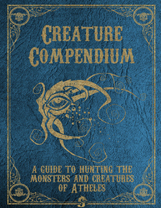 |
|
Sagaborn Creature Compendium (Lone Wanderer Entertainment, 2018, #230)
|
This bestiary is intended to serve as a core rulebook for the Dark Return/SagaBorn Role Playing Game. We are not familiar with this game and, to be honest, we have no intention of exploring a new system of fantasy RPG game mechanics. That said, we love bestiaries of all kinds and we especially love bestiaries produced outside the industry mainstream. In this respect, we appreciate the Sagaborn Creature Compendium. There is a refreshing inhomogeneity in the style of the illustrations. There is a freshness in the lack of editorial polish that reveals an individual labor of love. The book primarily provides interpretations of familiar monsters, converted to this system. However, there are a few new creatures sprinkled through-out the book.
|
|
|
|
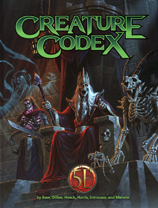 |
|
Creature Codex (Kobold Press, 2018, #234)
|
Kobold Press has made it a mission to provide gamemasters a great variety of choices in foes for their campaigns, where the monster statistics have already been converted to Fifth Edition D&D. The first of these massive volumes was The Tome of Beasts (#136) published in 2016. Creature Codex is a second volume in the series. While there are plenty of entries that are conversions of familiar monsters, the developers have done a good job in introducing a healthy dose of original creatures as well. These two books represent a major supplement to the Fifth Edition D&D game, because the official bestiaries, such as Mordenkainen's Tome of Foes and Guildmasters' Guide to Ravnica, described above, are much more limited in their offerings.
|
|
|
|
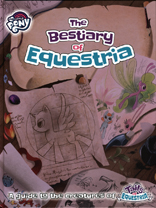 |
|
The Bestiary of Equestria (Shinobi7 & River Horse Games, 2018, #235)
|
Silly rabbit, bestiaries are for kids! Among the staff of the Poison Pie Publishing House, there is a father who managed to induce his daughter into the world of fantasy RPG's only by exploiting her love of ponies and of the My Little Pony franchise in particular. David Silver Games made this possible with their third-party Ponyfinder books. The Ponyfinder Everglow Bestiary (#147) is much loved.
Years later, an official My Little Pony RPG has been developed. While the reviews of the core rulebook largely focus on an absence of careful editing, the corresponding bestiary, The Bestiary of Equestria seems relatively well put together. As a licensed My Little Pony product, this book is able to include famous ponies (Twilight Sparkle, Rainbow Dash, Pinkie Pie etc.) in the bestiary, which was not possible with Ponyfinder. To be clear, the Ponyfinder books bring ponies as a playable race into the Pathfinder RPG, while the Tails of Equestria do the same but with an independent system of game mechanics.
On an at best peripherally related side note, the intersection of My Little Pony and Dungeons & Dragons is predated by this set of dice, featured in the addendum to An Introductory Guide to Cleromancy, located at the Poison Pie Publishing House.
|
|
|
|
|
More book reviews from the Poison Pie Publishing House
|
|
|
|
|

